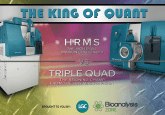Editor highlights: EBF 2020

The 13th EBF Open Symposium took place in cyberspace this year (17–20 November 2020). The online conference featured international speakers, exhibitors and posters. In this round-up, we summarize some of our highlights from attending the virtual conference.
COVID-19 – a pandemic uniting science
The first day of the conference especially focused on COVID-19 and how scientists have worked collaboratively to explore possible treatments and diagnostic tests. Patient-centric sampling was a key theme, highlighted by Melanie Anderson (Merck, PA, USA), as the need to collect samples at home has dramatically increased due to the pandemic. She explained how over 20 collection kits have EUA approval and are being used for at-home collection of samples for molecular tests. There has also been increased investment and demand for devices that enable remote biological sample collection, which is impacting the device manufacturers. Anderson explained how clinical trials had to close due the pandemic to ensure participant and staff safety, however, alternative at-home sampling has been used globally to support social distancing in ongoing clinical trials. She concluded by remarking how the pandemic is changing the way sponsors are thinking about patient-centric sampling and driving a change across the healthcare industry in the way collection devices are used.
Enhanced usage and recent developments in chromatographic separations
In this session Aaron Ledvina (Covance, WI, USA) presented on high-sensitivity workflows for LC–MS based analysis of oligonucleotides. He spoke about the key challenges of using oligonucleotides as drug candidates, which include their in vivo and in vitro instability and polarity. In the past both LC–MS and hybridization-based assays have been used for analysis, with both having advantages and disadvantages. Ledvina discussed how LC–MS works well for smaller oligonucleotides compared to hybridization-assays, which tend to suit larger oligonucleotide analysis. He also explained the two different LC–MS approaches – HRMS, which enables high selectivity with no need to fragment and triple quad, which has superior sensitivity and enables straight forward data processing.
Biomarker assays and context-of-use
Context-of-use is central to biomarker qualification as it is a complete statement that describes the appropriate use of the biomarker and how the qualified biomarker is applied in drug development and regulatory review. In this session key considerations were highlighted when developing a biomarker assay, which included the observed or anticipated biomarker levels, development Phase in which the biomarker is measured, decisions taken from the biomarker data (efficacy, safety etc.) and fit of the assay with regulated bioanalysis guidelines. Joanne Goodman (AstraZeneca, Cambridge, UK) explained how these biomarker classification systems should be applied together to tailor an individual bioanalytical strategy in support of a biomarker assay request. EBF have also published a recommendation article on biomarker assays, which can be viewed here ‘Update to the European Bioanalysis Forum recommendation on biomarkers assays; bringing context of use into practice’.
Protein bioanalysis by LC–MS
In this session, chaired by Matt Barfield (Roche, Stevenage, UK), an overview of protein bioanalysis was given, looking at how trends in techniques have changed over time. For example, in the past LC–MS was the preferred method by most, compared to now where more hybridization techniques are being used. It was clear that there is still confusion over which acceptance criteria to use when conducting protein bioanalysis with some people using the small molecule acceptance and others using large molecule acceptance criteria. However, has technology developed enough to allow a more harmonized approach? Has the difference between performance of LBA and chromatography not become small enough to entertain this proposal? These key questions were discussed explaining how acceptance criteria for Bioanalytical Method Validation is being redefined based on data, moving away from technology-based criteria.
Despite the coronavirus pandemic, it was a pleasure to still be able to attend the conference virtually, as it highlighted the importance of continuing to share knowledge and collaborate globally.




